Welcome to Valhalla: Inside the New 250GB Xbox 360 Slim
by Anand Lal Shimpi on June 18, 2010 1:59 AM ESTI own a total of five Xbox 360s. Four of them have died. Three because of the Red Ring of Death, all out of warranty. Many have had serial Xbox 360 failures, I had them in parallel.
The last revision of the Xbox 360, codenamed Jasper, was supposed to fix the infamous RRoD problem. So far my Jasper has been running fine. While Microsoft never confirmed the cause the RRoD seemed to be a result of poor cooling and manufacturing issues (either at the die/underfill level or at the solder level or both).
Needless to say, I wasn’t terribly happy about purchasing a sixth Xbox 360, but here it is:
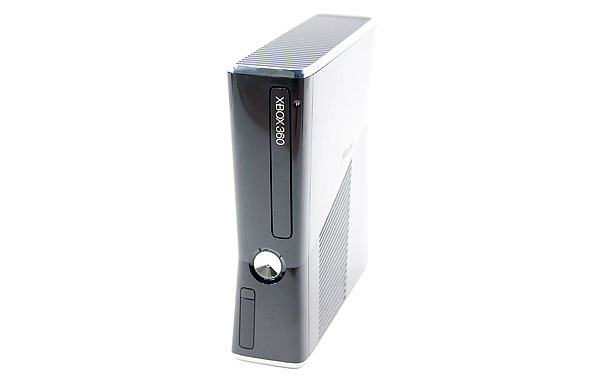
This is the latest revision of the Xbox 360, commonly referred to as the Xbox 360 Slim thanks to its shrinking in virtually all dimensions compared to the previous white box:
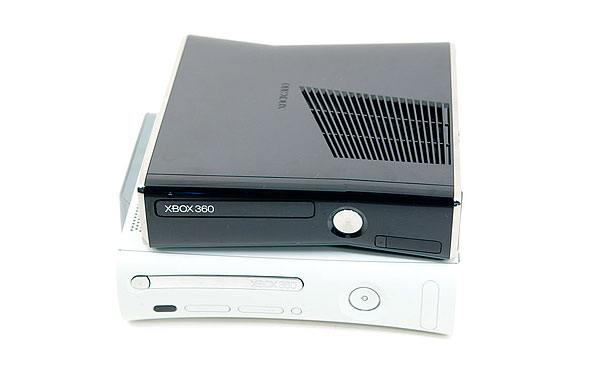

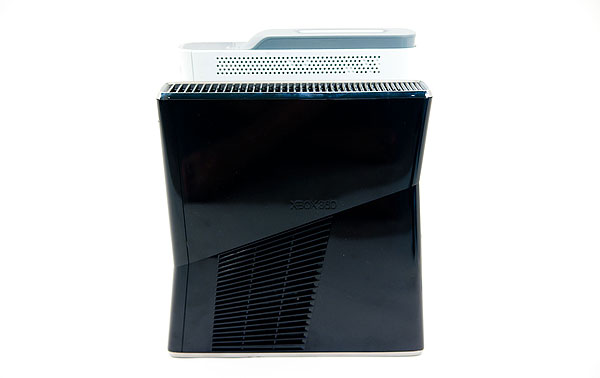
The internals are mostly new, featuring for the first time a single chip with CPU, GPU and eDRAM. Prior to this motherboard revision the Xbox 360 motherboard had two discrete packages, one with the CPU and one with the GPU + eDRAM.
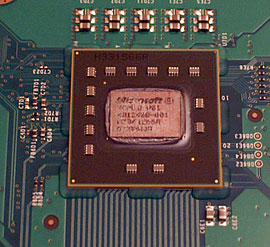 |
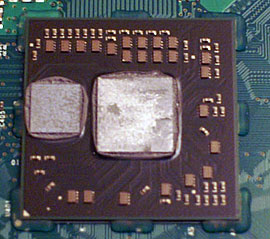 |
For those of you who don't remember, ATI originally designed the Xbox 360's GPU and called it Xenos. The GPU was the first we ever looked at that used a unified shading architecture, so there were no dedicated pixel or vertex units. The core was made up of 48 shader processors and each SP could work on a vect4 plus a scalar op in parallel. These days we'd probably call it a GPU with 240 cores, although it's a bit dated from a functionality standpoint. The GPU runs at 500MHz and is also home to the memory controller.

On a separate die, which ATI referred to as the daughter die, was 10MB of embedded DRAM along with all of the hardware necessary for z and stencil operations, color and alpha processing and AA. This eDRAM and associated logic helped Microsoft bring AA to games and improve overall performance compared to what was possible at the time with conventional architectures.
The CPU, codenamed Xenon, implemented three in-order PowerPC cores with SMT support - meaning the whole chip could work on six threads at the same time. The design was ahead of its time but given its 90nm manufacturing process it only had 1MB of L2 cache to share among all three cores. These days it isn't really considered the ideal approach to a many-core CPU. Private L2 caches with a large shared L3 cache is preferred for scaling beyond two cores.
Leading up to Jasper, each die was shrunk independently with each Xbox iteration. The table below shows us how:
| Xbox 360 Revision | CPU | GPU | eDRAM |
| Xenon/Zephyr | 90nm | 90nm | 90nm |
| Falcon/Opus | 65nm | 80nm | 80nm |
| Jasper | 65nm | 65nm | 80nm |
With the new Xbox 360 (codenamed Valhalla), at least two, possibly all three of the die are combined and placed on a single package:

Bringing it all onto (presumably) a single die makes cooling much simpler as now there’s only one heatsink and one fan for all of the major heat generating components in the unit. This level of integration is made possible only by the not-so-magic of Moore’s Law. At 40nm it shouldn’t be a problem to bring all of those components onto a single reasonably sized die, which in turn reduces Microsoft’s manufacturing costs. It’s not totally clear whether Microsoft is building these chips on a 40nm, 45nm or 55nm node. The 40nm approach would make the most sense but TSMC is very capacity constrained at this point so it would be a slow ramp before all Xboxes got the Valhalla treatment. Update: Apparently 45nm is the magic number. The new CGPU is rumored to be made at Chartered Semiconductor, now under the ownership of Global Foundries.
The uncertainty is because of a pesky heat spreader. While previous Xbox 360 CPU/GPUs were visible to the naked eye once you popped the heatsink off, the Valhalla design has a heat spreader covering the Xbox CGPU (Microsoft’s term, not mine). Unwilling to potentially kill yet another Xbox 360, I’ve left my heat spreader intact for the purposes of this article.
What follows is an entire dissection guide for those of you who want to get inside the new Xbox 360 (for whatever reason you might have ;), as well as some power/noise information for those of you contemplating the upgrade.
Enjoy.










109 Comments
View All Comments
Anand Lal Shimpi - Friday, June 18, 2010 - link
I'm guessing cost more than anything else, this thing has to be as cheap as possible in order to turn a profit.Take care,
Anand
landerf - Friday, June 18, 2010 - link
Slim DVD drive's cost more and are slower to read discs. Having engineered a HTPC that fits into a 360 case with a full size drive, psu, and real gfx card (90 degree pci-e riser) I can tell you it's all about engineering smartly. If there's plenty of room for something bigger but cheaper then that's just what makes sense to use.Guspaz - Friday, June 18, 2010 - link
The 360 uses a 12x DVD drive, so at least the rotational speed of the drive isn't hard to match (slim drives also go up to 12x). I'm not sure if the average seek time would be fast enough in a slim drive, though.Another consideration is that a slim drive would have required Microsoft to switch to a slot loading system like Nintendo and Sony use; a slim tray would be too flimsy for a console, and requiring the user to snap the disk onto the central spindle might have been a bit awkward.
To be honest, though, I'd rather have had the new xbox use a slot-loading slim drive and an internal power supply.
adam92682 - Friday, June 18, 2010 - link
The Saturn, Playstation, and Gamecube required the user to snap the disc onto the central spindle.nubie - Friday, June 18, 2010 - link
Ha, you forgot the Dreamcast and Sega CD.Seriously, that doesn't look like a full-size drive to me (I could be wrong). Not a slmiline drive, but doesn't seem full-size to me. Since they are using custom drives all they need be concerned with is the size of the actual electro-mechanical bits and circuit boards.
I like the HS design, looks like an OEM bundled PC HS/Fan, maybe we will see some heatpipe versions.
I like the HDD tray, looks like with a simple plastic carrier you can slot in any laptop style HDD. (Or just stuff newspapers around it if you don't care about fire.)
sprockkets - Friday, June 18, 2010 - link
Limited to 8x. Unless you can show me a 12x drive. They've been stuck on 8x for years.NaMcOJR - Saturday, June 19, 2010 - link
It's the only thing that's missing there, yeah...rorrim180 - Sunday, November 28, 2010 - link
I would guess that they could not implement a mechanism to close the tray if they used a slim drive.arnavvdesai - Friday, June 18, 2010 - link
While power has increased considerably for the PC counterparts, I still dont see any better cooling methods introduced. Even if were to assume that Microsoft would stick a 5870 into their box I dont see how they can cool such a beast in a small form factor. We would need to move to a lower die size in order to be able to adequately cool the device. Also, we need to remember that TVs have a hit the 1080p mark and will not move to a higher resolution anytime soon, so console makers will have to push technology in different area of improvements. Also, what about buffers for the GPU? While CPUs can make do with 12 MB of L3 cache what about GPUs. With higher textures we need the ability to feed the beast and consoles will need to somehow figure that out.Also game developers have not really demanded higher capabilities from the consoles. I have a 5870 in my PC and having played the same games on PC and my 360 I dont see much difference in fidelity .
We must also remember that software for this generation cost a lot more to develop for. This means that if a new technology was introduced they would have to optimize for it at an even higher cost and most devs are not ready for it.
The only reason I see in the future which would demand more power from consoles is 3D. If significant market penetration is achieved (which is a long way IMHO) then and only then will we demand more from our consoles. Also, Microsoft will have a tough choice when it comes to the media they want their games to be on. Blu-Ray seems to be the only alternative at the moment and I am sure Microsoft would prefer something more( them getting that is a different thing altogether)
Earthmonger - Friday, June 18, 2010 - link
I'll state here what I stated elsewhere: This thing looks like a fat woman sat on a DVD player. What were they thinking? I don't want it anywhere near my EC.Hopefully someone will put out some decent-looking aftermarket cases. And at just $300, warranty isn't really a concern.